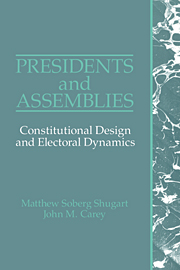Book contents
- Frontmatter
- Contents
- List of tables and figures
- Acknowledgments
- 1 Basic choices in democratic regime types
- 2 Defining regimes with elected presidents
- 3 Criticisms of presidentialism and responses
- 4 The premier-presidential and president-parliamentary experiences
- 5 The constitutional origins of chief executives
- 6 Constitutional limits on separate origin and survival
- 7 Legislative powers of presidents
- 8 Assessing the powers of the presidency
- 9 Electoral dynamics: efficiency and inefficiency
- 10 Electoral rules and the party system
- 11 Electoral cycles and the party system
- 12 Electoral cycles and compatibility between president and assembly
- 13 Conclusions
- Appendix A Electoral rules for one-seat districts and coalition-building incentives
- Appendix B Theoretical explanation for models predicting number of parties in presidential systems
- Bibliography
- Index
11 - Electoral cycles and the party system
Published online by Cambridge University Press: 05 June 2012
- Frontmatter
- Contents
- List of tables and figures
- Acknowledgments
- 1 Basic choices in democratic regime types
- 2 Defining regimes with elected presidents
- 3 Criticisms of presidentialism and responses
- 4 The premier-presidential and president-parliamentary experiences
- 5 The constitutional origins of chief executives
- 6 Constitutional limits on separate origin and survival
- 7 Legislative powers of presidents
- 8 Assessing the powers of the presidency
- 9 Electoral dynamics: efficiency and inefficiency
- 10 Electoral rules and the party system
- 11 Electoral cycles and the party system
- 12 Electoral cycles and compatibility between president and assembly
- 13 Conclusions
- Appendix A Electoral rules for one-seat districts and coalition-building incentives
- Appendix B Theoretical explanation for models predicting number of parties in presidential systems
- Bibliography
- Index
Summary
As mentioned in Chapter 10, most studies of the relationship between votes and seats have not taken into account the possibility that presidential and parliamentary systems might differ on the relations being investigated. Indeed, most have been based overwhelmingly, if not exclusively, on data from parliamentary systems. The empirical results of Chapter 10 suggest that presidential systems might make a difference in two ways. The first, and most obvious, is that, unlike parliamentary systems, presidential systems have separate elections for two separate agents of the electorate. The second, which flows directly from the first, is that these elections need not be at the same time; we have seen that the timing of elections, the electoral cycle, makes a difference in the number of parties. If the number of parties varies, so perhaps do such outcomes as the extent and quality of representation and the stability and effectiveness of the system. If concurrent elections by PR are employed along with plurality for the president, those wishing to articulate minority viewpoints might find themselves forced either to join a large presidential contender's party or else suffer electorally as a third party. Then, perhaps, the degree to which the system represents diversity may be undercut. On the other hand, if nonconcurrent elections are used, presidents might find they rarely have majorities in the congress.
ROLE OF ASSEMBLIES AND THE NUMBER OF PARTIES
A principal theme of this book has been that assemblies do not exist in institutional isolation within their political systems.
- Type
- Chapter
- Information
- Presidents and AssembliesConstitutional Design and Electoral Dynamics, pp. 226 - 258Publisher: Cambridge University PressPrint publication year: 1992

